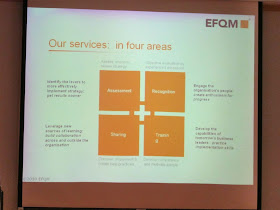Ms. Carla Guerra (Programme Manager of Partnerships and Publications, EFQM) was the speaker and her topic included introduction of EFQM model and EFQM membership foundation.
In the beginning, Ms. Guerra briefed EFQM model through 9 steps.

The 1st step was ONE Model. It included Body of Knowledge (BoK) about sustainable high performing organization, as well as, organization beliefs and values. It used a framework to align and benchmarking with others.

The 2nd step was TWO Sides. The framework separated into Enablers and Results. Enablers contained different working approach which could impact the result. Results demonstrated organization performance in the past, present and future.
The 3rd step was THREE Dimensions such as Concepts, Criteria and Comparison.

The 4th step was FOUR Stakeholders to be balance. They were Shareholders, Customers, People and Society.
The 5th step was FIVE Enablers.
Leadership: the power of make it or break it
Strategy: to plan and follow-up
People: staff connecting the resources with the processes
Partnerships & Resources: all things needs
Products & Services: results obtained

The 6th step was SIX Working Practices / Criterion Part
There were 132 working example for member sharing.
The 7th step was SEVEN Questions on Enabler and Results.

The 8th step was EIGHT Fundamental Concepts.
i) Achieving Balanced Results: a balanced set of result met both the short and long term needs.
ii) Adding Value for Customers: create value by understanding and anticipating customer needs and expectations
iii) Leading with Vision, Inspiration & Integrity: Leadership to shape the future and make it happen
iv) Managing by Processes: structured and strategically aligned processes using fact-based decision making
v) Succeeding through People: culture of empowerment for the organization and personal goals
vi) Nurturing Creativity & Innovation: continual and systematic innovation by harnessing the creativity of their stakeholders
vii) Building Partnerships: built trusting relationships with various partners to ensure mutual success
viii) Taking Responsibility for a Sustainable Future: culture and ethical mindset, clear values and the highest standards for organizational behaviour.

The 9th step was NINE Criteria.
For Enablers: Leadership, People, Strategy, Partnership & Resources and Processes, Products & Services
For Results: People Results, Customer Results, Society Results and Key Results

Then Ms. Guerra introduced what is EFQM.
EFQM is a global non-for-profit membership foundation based in Brussels, Belgium since 1989. With more than 500 members covering more than 55 countries and 50 industries, they provide a unique platform for organizations to learn from each other and improve performance.

EFQM had three competencies including Assessment, Accelerating Learning and Bringing Diverse Companies Together.

EFQM had four key services.
Assessing – Plot your progress
Sharing – Exchange your experiences
Training – Treasure your talent
Recognition – Celebrate your success

EFQM has more than 500 members, some members showed below.





沒有留言:
發佈留言